2006 BMW Z4 3.0SI ROADSTER seats
[x] Cancel search: seatsPage 32 of 128
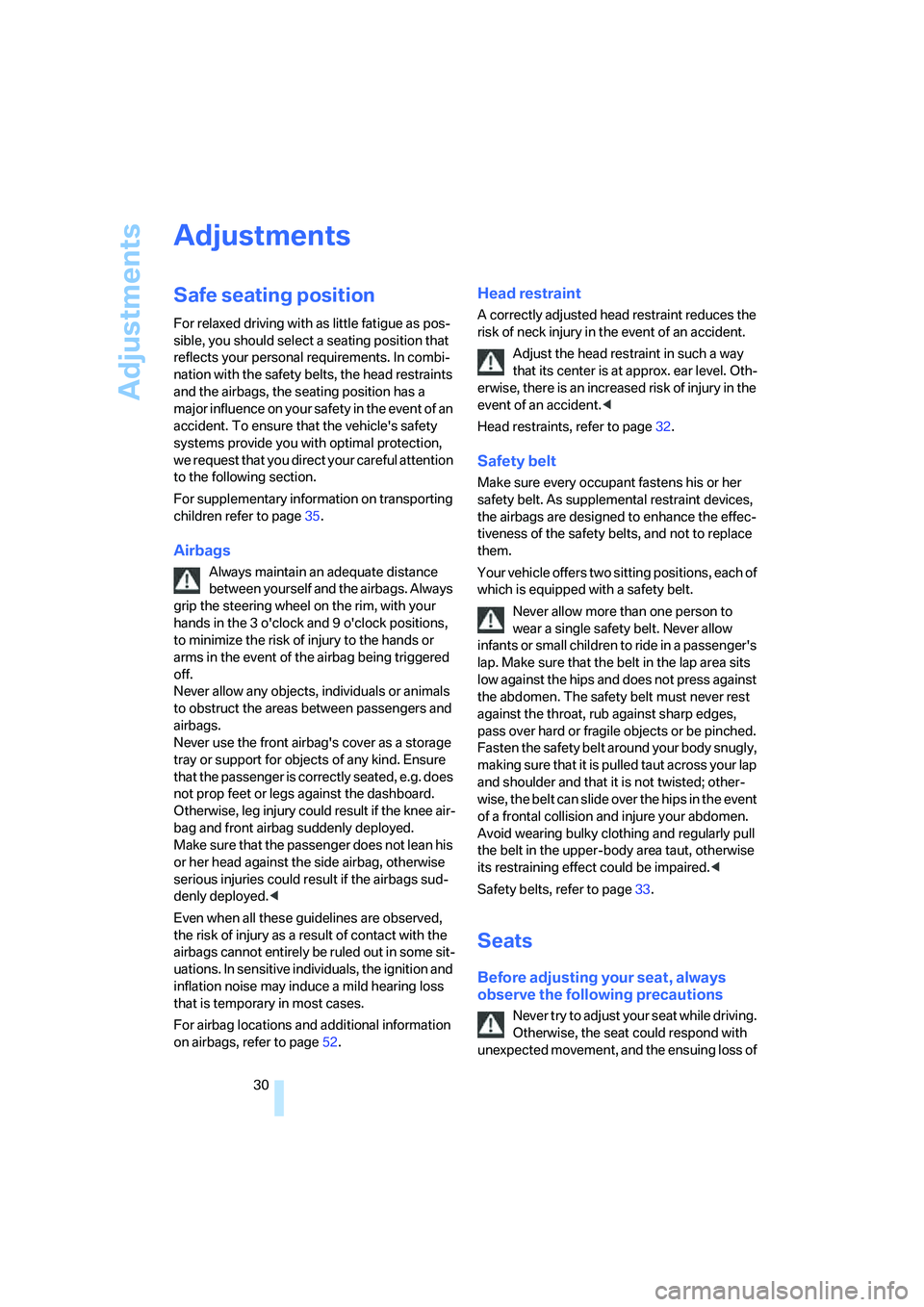
Adjustments
30
Adjustments
Safe seating position
For relaxed driving with as little fatigue as pos-
sible, you should select a seating position that
reflects your personal requirements. In combi-
nation with the safety belts, the head restraints
and the airbags, the seating position has a
major influence on your safety in the event of an
accident. To ensure that the vehicle's safety
systems provide you with optimal protection,
we request that you direct your careful attention
to the following section.
For supplementary information on transporting
children refer to page35.
Airbags
Always maintain an adequate distance
between yourself and the airbags. Always
grip the steering wheel on the rim, with your
hands in the 3 o'clock and 9 o'clock positions,
to minimize the risk of injury to the hands or
arms in the event of the airbag being triggered
off.
Never allow any objects, individuals or animals
to obstruct the areas between passengers and
airbags.
Never use the front airbag's cover as a storage
tray or support for objects of any kind. Ensure
that the passenger is correctly seated, e.g. does
not prop feet or legs against the dashboard.
Otherwise, leg injury could result if the knee air-
bag and front airbag suddenly deployed.
Make sure that the passenger does not lean his
or her head against the side airbag, otherwise
serious injuries could result if the airbags sud-
denly deployed.<
Even when all these guidelines are observed,
the risk of injury as a result of contact with the
airbags cannot entirely be ruled out in some sit-
uations. In sensitive individuals, the ignition and
inflation noise may induce a mild hearing loss
that is temporary in most cases.
For airbag locations and additional information
on airbags, refer to page52.
Head restraint
A correctly adjusted head restraint reduces the
risk of neck injury in the event of an accident.
Adjust the head restraint in such a way
that its center is at approx. ear level. Oth-
erwise, there is an increased risk of injury in the
event of an accident.<
Head restraints, refer to page32.
Safety belt
Make sure every occupant fastens his or her
safety belt. As supplemental restraint devices,
the airbags are designed to enhance the effec-
tiveness of the safety belts, and not to replace
them.
Your vehicle offers two sitting positions, each of
which is equipped with a safety belt.
Never allow more than one person to
wear a single safety belt. Never allow
infants or small children to ride in a passenger's
lap. Make sure that the belt in the lap area sits
low against the hips and does not press against
the abdomen. The safety belt must never rest
against the throat, rub against sharp edges,
pass over hard or fragile objects or be pinched.
F a s t e n t he s a f e t y b e l t a ro u n d y o u r b o d y s n u g l y,
ma king sure tha t it is pulled taut across your lap
and shoulder and that it is not twisted; other-
wise, the belt can slide over the hips in the event
of a frontal collision and injure your abdomen.
Avoid wearing bulky clothing and regularly pull
the belt in the upper-body area taut, otherwise
its restraining effect could be impaired.<
Safety belts, refer to page33.
Seats
Before adjusting your seat, always
observe the following precautions
Never try to adjust your seat while driving.
Otherwise, the seat could respond with
unexpected movement, and the ensuing loss of
Page 37 of 128
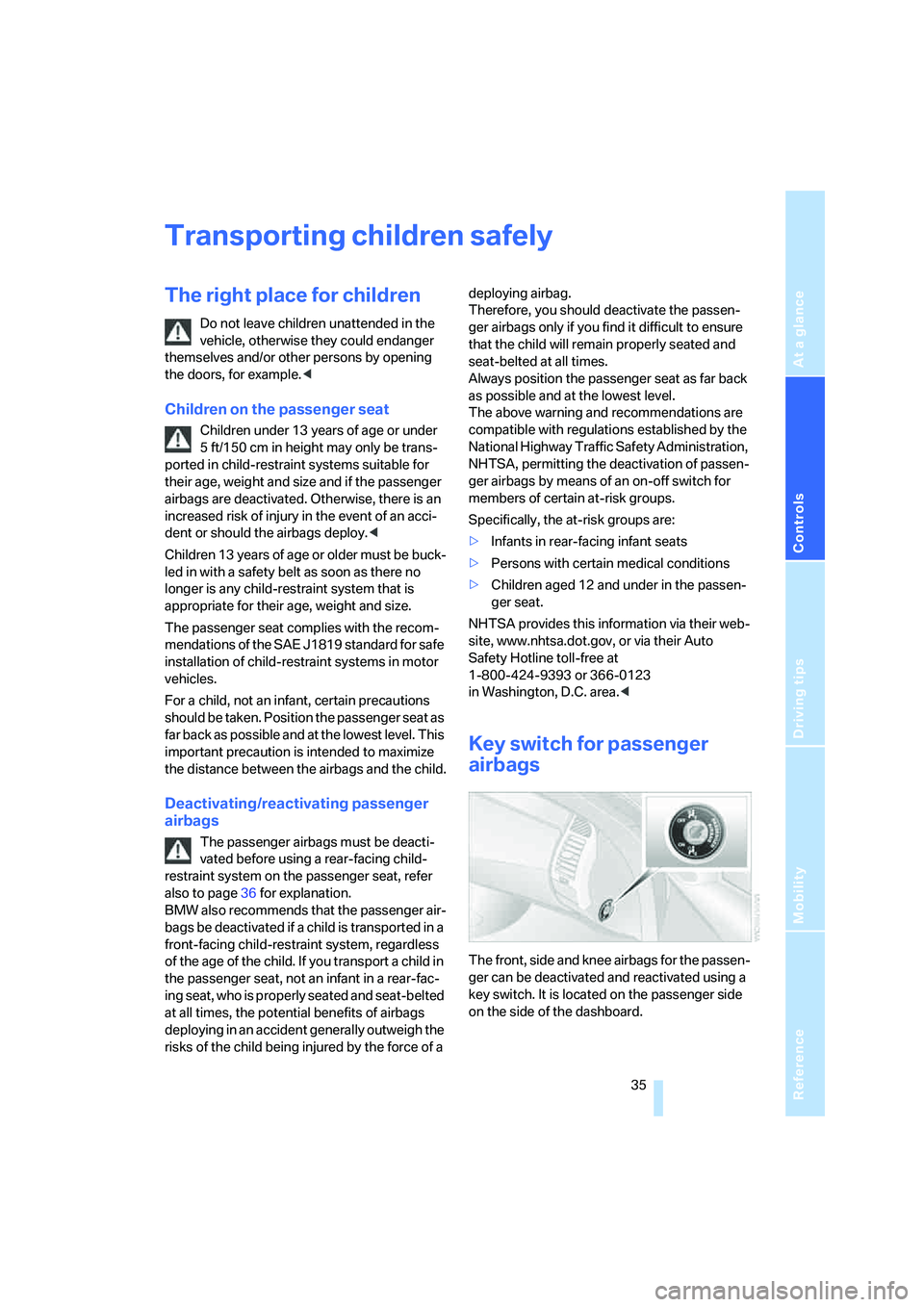
Reference
At a glance
Controls
Driving tips
Mobility
35
Transporting children safely
The right place for children
Do not leave children unattended in the
vehicle, otherwise they could endanger
themselves and/or other persons by opening
the doors, for example.<
Children on the passenger seat
Children under 13 years of age or under
5ft/150cm in height may only be trans-
ported in child-restraint systems suitable for
their age, weight and size and if the passenger
airbags are deactivated. Otherwise, there is an
increased risk of injury in the event of an acci-
dent or should the airbags deploy.<
Children 13 years of age or older must be buck-
led in with a safety belt as soon as there no
longer is any child-restraint system that is
appropriate for their age, weight and size.
The passenger seat complies with the recom-
mendations of the SAE J1819 standard for safe
installation of child-restraint systems in motor
vehicles.
For a child, not an infant, certain precautions
should be taken. Position the passenger seat as
far back as possible and at the lowest level. This
important precaution is intended to maximize
the distance between the airbags and the child.
Deactivating/reactivating passenger
airbags
The passenger airbags must be deacti-
vated before using a rear-facing child-
restraint system on the passenger seat, refer
also to page36 for explanation.
BMW also recommends that the passenger air-
bags be deactivated if a child is transported in a
front-facing child-restraint system, regardless
of the age of the child. If you transport a child in
the passenger seat, not an infant in a rear-fac-
ing seat, who is properly seated and seat-belted
at all times, the potential benefits of airbags
deploying in an accident generally outweigh the
risks of the child being injured by the force of a deploying airbag.
Therefore, you should deactivate the passen-
ger airbags only if you find it difficult to ensure
that the child will remain properly seated and
seat-belted at all times.
Always position the passenger seat as far back
as possible and at the lowest level.
The above warning and recommendations are
compatible with regulations established by the
National Highway Traffic Safety Administration,
NHTSA, permitting the deactivation of passen-
ger airbags by means of an on-off switch for
members of certain at-risk groups.
Specifically, the at-risk groups are:
>Infants in rear-facing infant seats
>Persons with certain medical conditions
>Children aged 12 and under in the passen-
ger seat.
NHTSA provides this information via their web-
site, www.nhtsa.dot.gov, or via their Auto
Safety Hotline toll-free at
1-800-424-9393 or 366-0123
in Washington, D.C. area.<
Key switch for passenger
airbags
The front, side and knee airbags for the passen-
ger can be deactivated and reactivated using a
key switch. It is located on the passenger side
on the side of the dashboard.
Page 66 of 128
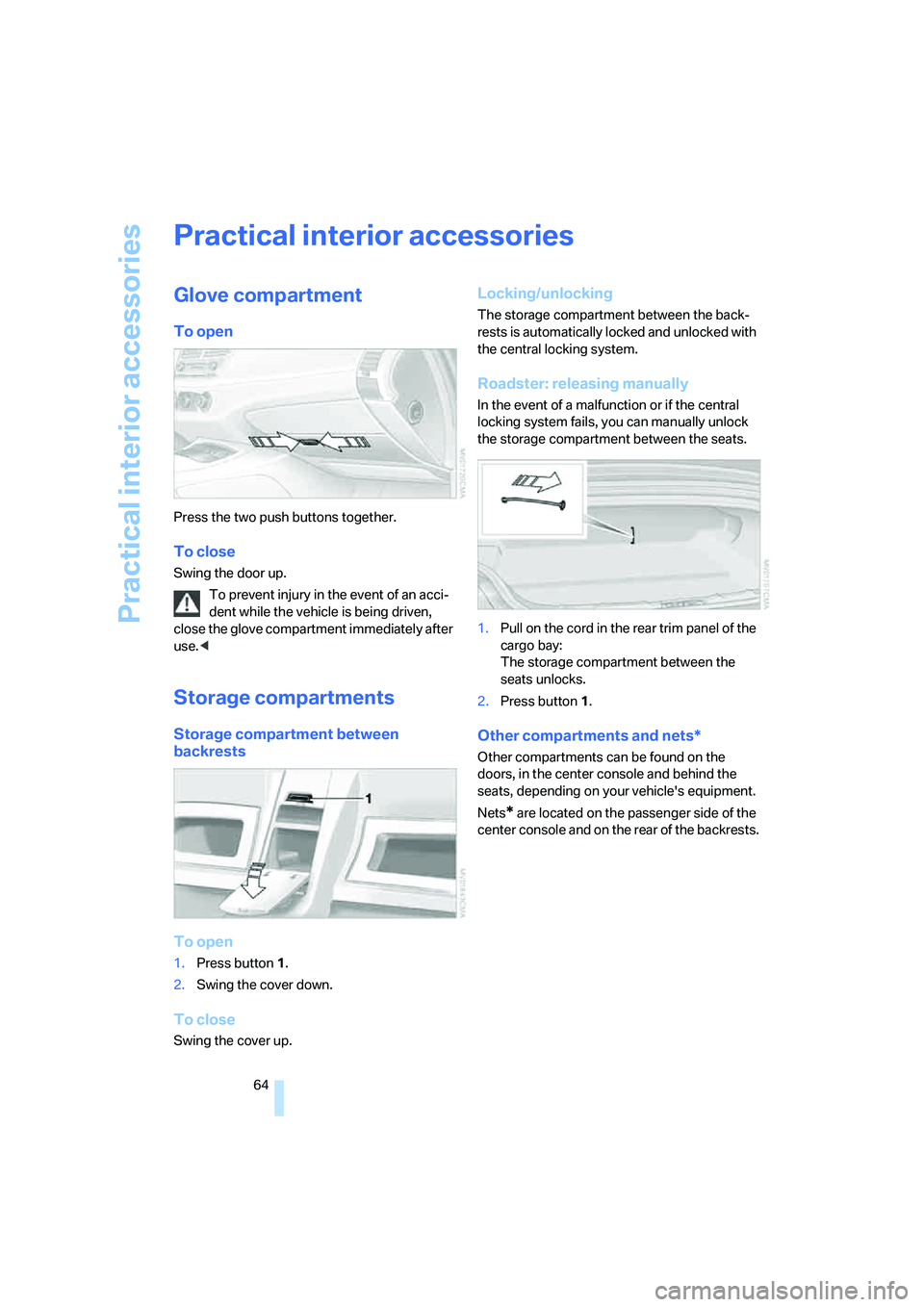
Practical interior accessories
64
Practical interior accessories
Glove compartment
To open
Press the two push buttons together.
To close
Swing the door up.
To prevent injury in the event of an acci-
dent while the vehicle is being driven,
close the glove compartment immediately after
use.<
Storage compartments
Storage compartment between
backrests
To open
1.Press button1.
2.Swing the cover down.
To close
Swing the cover up.
Locking/unlocking
The storage compartment between the back-
rests is automatically locked and unlocked with
the central locking system.
Roadster: releasing manually
In the event of a malfunction or if the central
locking system fails, you can manually unlock
the storage compartment between the seats.
1.Pull on the cord in the rear trim panel of the
cargo bay:
The storage compartment between the
seats unlocks.
2.Press button1.
Other compartments and nets*
Other compartments can be found on the
doors, in the center console and behind the
seats, depending on your vehicle's equipment.
Nets
* are located on the passenger side of the
center console and on the rear of the backrests.
Page 75 of 128
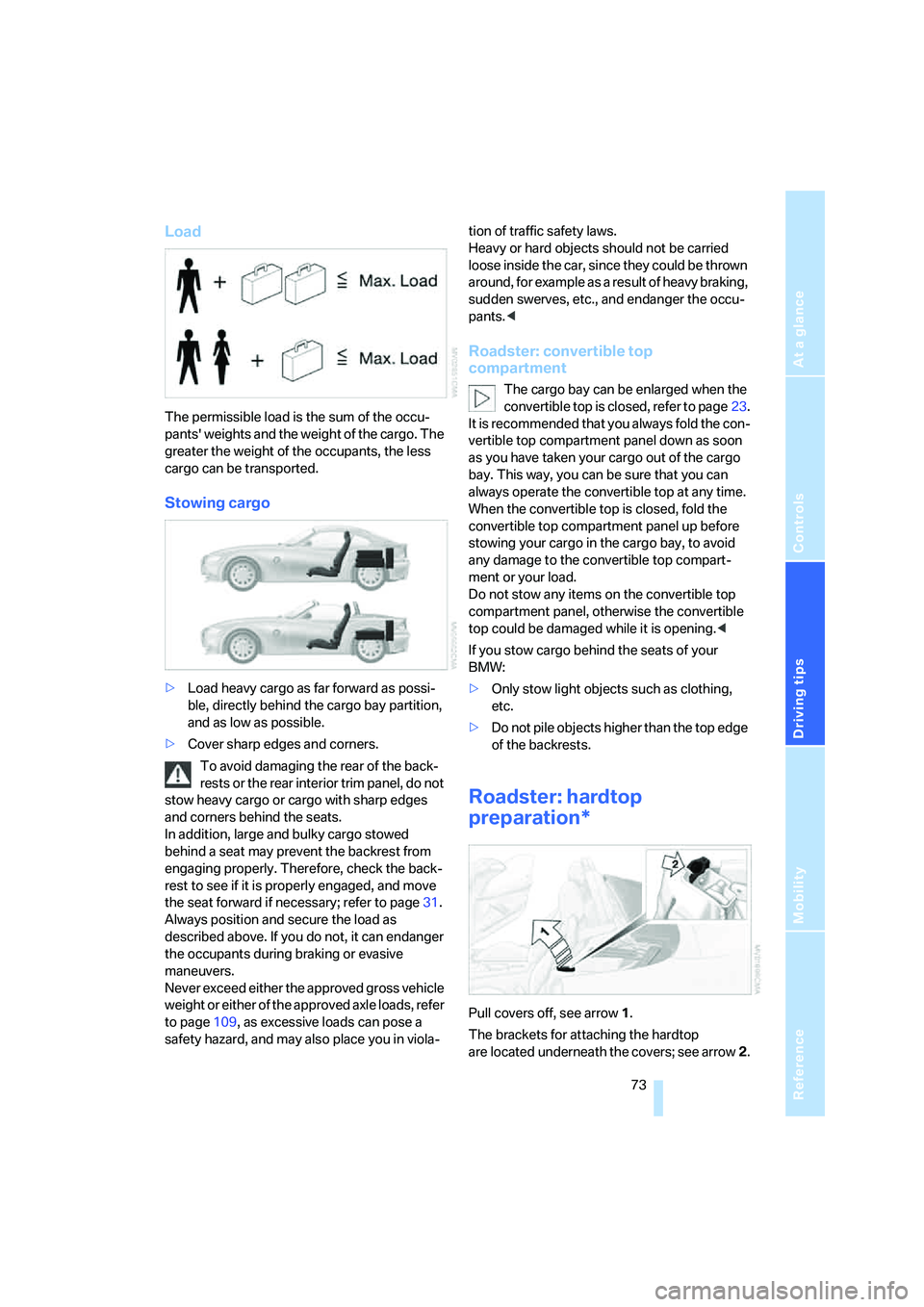
Reference
At a glance
Controls
Driving tips
Mobility
73
Load
The permissible load is the sum of the occu-
pants' weights and the weight of the cargo. The
greater the weight of the occupants, the less
cargo can be transported.
Stowing cargo
>Load heavy cargo as far forward as possi-
ble, directly behind the cargo bay partition,
and as low as possible.
>Cover sharp edges and corners.
To avoid damaging the rear of the back-
rests or the rear interior trim panel, do not
stow heavy cargo or cargo with sharp edges
and corners behind the seats.
In addition, large and bulky cargo stowed
behind a seat may prevent the backrest from
engaging properly. Therefore, check the back-
rest to see if it is properly engaged, and move
the seat forward if necessary; refer to page31.
Always position and secure the load as
described above. If you do not, it can endanger
the occupants during braking or evasive
maneuvers.
Never exceed either the approved gross vehicle
weight or either of the approved axle loads, refer
to page109, as excessive loads can pose a
safety hazard, and may also place you in viola-tion of traffic safety laws.
Heavy or hard objects should not be carried
loose inside the car, since they could be thrown
around, for example as a result of heavy braking,
sudden swerves, etc., and endanger the occu-
pants.<
Roadster: convertible top
compartment
The cargo bay can be enlarged when the
convertible top is closed, refer to page23.
I t i s r e c o m m e n d ed t h a t y o u a lw a y s f o l d t h e c o n -
vertible top compartment panel down as soon
as you have taken your cargo out of the cargo
bay. This way, you can be sure that you can
always operate the convertible top at any time.
When the convertible top is closed, fold the
convertible top compartment panel up before
stowing your cargo in the cargo bay, to avoid
any damage to the convertible top compart-
ment or your load.
Do not stow any items on the convertible top
compartment panel, otherwise the convertible
top could be damaged while it is opening.<
If you stow cargo behind the seats of your
BMW:
>Only stow light objects such as clothing,
etc.
>Do not pile objects higher than the top edge
of the backrests.
Roadster: hardtop
preparation*
Pull covers off, see arrow1.
The brackets for attaching the hardtop
are located underneath the covers; see arrow2.
Page 114 of 128

Everything from A to Z
112
Everything from A to Z
Index
A
ABS Antilock Brake
System49
– indicator lamp12
Accident, refer to Emergency
call98
Acknowledgment signal for
locking/unlocking vehicle19
Activated-charcoal filter for
automatic climate control63
Additives
– coolant89
– engine oil89
Adjusting
– seats30
Adjusting the thigh support32
Airbags52
– deactivating36
– indicator/warning lamp13
– passenger airbags indicator
lamp36
– reactivation36
– safe seating position30
Airbag switch, refer to Key
switch for passenger
airbags35
Air conditioning58
Air-conditioning operation,
refer to Cooling
function59,62
Air distribution
– air conditioning59
– automatic climate control62
– individual59,62
Air flow rate
– air conditioning59
– automatic climate control62
Airing out, refer to
Ventilation59,63
Air outlets, refer to
Ventilation59,63Air pressure, refer to Tire
inflation pressure80
Air recirculation, refer to
Recirculated-air
mode59,63
AKI, refer to Fuel
specifications79
Alarm system23
– avoiding unintentional
alarms24
– interior motion sensor24
– switching off an alarm24
– tilt alarm sensor24
All-season tires, refer to
Winter tires83,85
Ambient air, refer to
Recirculated-air
mode59,63
Ambient temperature
display46
Antenna, refer to the Caring
for your vehicle brochure
Antifreeze44,89
– coolant89
– washer fluids44
Antilock Brake System
ABS49
– indicator/warning lamp12
– indicator lamp13
Anti-theft alarm system, refer
to Alarm system23
Anti-theft protection19,23
Approved engine oils89
Artificial leather, refer to the
Caring for your vehicle
brochure
Ashtray65
Assistance systems, refer to
Driving stability control
systems49
AUC Automatic recirculated-
air control63Automatic
– air distribution62
– air flow rate62
– cruise control44
– headlamp control55
– luggage compartment lid
operation22
– recirculated-air control
AUC63
– tailgate operation21
Automatic car wash, refer to
the Caring for your vehicle
brochure
Automatic climate control61
Automatic convertible top27
Automatic lamps55
Automatic transmission with
Steptronic40
– indicator lamp13
– interlock38,40
– selector lever41
– selector lever lock40
– shiftlock40
– shift paddles on steering
wheel41
– towing the vehicle101
– tow-starting101
AUTO program for automatic
climate control62
Average fuel consumption48
– setting unit of measure48
Average speed48
– setting unit of measure48
Avoiding unintentional
alarms24
Axle loads, refer to
Weights109
B
Backrests, refer to Seat
adjustment31
Page 118 of 128
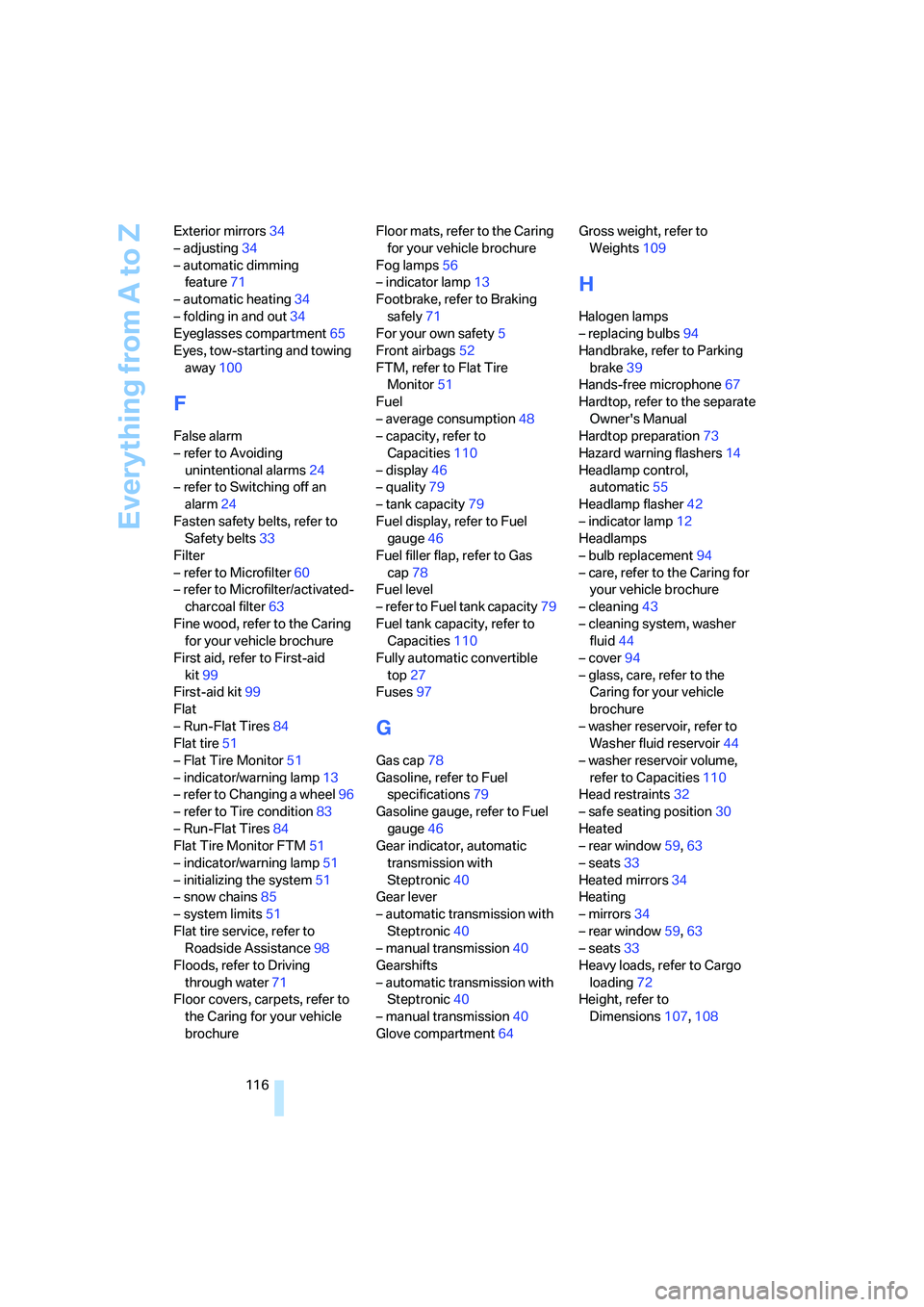
Everything from A to Z
116 Exterior mirrors34
– adjusting34
– automatic dimming
feature71
– automatic heating34
– folding in and out34
Eyeglasses compartment65
Eyes, tow-starting and towing
away100
F
False alarm
– refer to Avoiding
unintentional alarms24
– refer to Switching off an
alarm24
Fasten safety belts, refer to
Safety belts33
Filter
– refer to Microfilter60
– refer to Microfilter/activated-
charcoal filter63
Fine wood, refer to the Caring
for your vehicle brochure
First aid, refer to First-aid
kit99
First-aid kit99
Flat
– Run-Flat Tires84
Flat tire51
– Flat Tire Monitor51
– indicator/warning lamp13
– refer to Changing a wheel96
– refer to Tire condition83
– Run-Flat Tires84
Flat Tire Monitor FTM51
– indicator/warning lamp51
– initializing the system51
– snow chains85
– system limits51
Flat tire service, refer to
Roadside Assistance98
Floods, refer to Driving
through water71
Floor covers, carpets, refer to
the Caring for your vehicle
brochureFloor mats, refer to the Caring
for your vehicle brochure
Fog lamps56
– indicator lamp13
Footbrake, refer to Braking
safely71
For your own safety5
Front airbags52
FTM, refer to Flat Tire
Monitor51
Fuel
– average consumption48
– capacity, refer to
Capacities110
– display46
– quality79
– tank capacity79
Fuel display, refer to Fuel
gauge46
Fuel filler flap, refer to Gas
cap78
Fuel level
– refer to Fuel tank capacity79
Fuel tank capacity, refer to
Capacities110
Fully automatic convertible
top27
Fuses97
G
Gas cap78
Gasoline, refer to Fuel
specifications79
Gasoline gauge, refer to Fuel
gauge46
Gear indicator, automatic
transmission with
Steptronic40
Gear lever
– automatic transmission with
Steptronic40
– manual transmission40
Gearshifts
– automatic transmission with
Steptronic40
– manual transmission40
Glove compartment64Gross weight, refer to
Weights109
H
Halogen lamps
– replacing bulbs94
Handbrake, refer to Parking
brake39
Hands-free microphone67
Hardtop, refer to the separate
Owner's Manual
Hardtop preparation73
Hazard warning flashers14
Headlamp control,
automatic55
Headlamp flasher42
– indicator lamp12
Headlamps
– bulb replacement94
– care, refer to the Caring for
your vehicle brochure
– cleaning43
– cleaning system, washer
fluid44
– cover94
– glass, care, refer to the
Caring for your vehicle
brochure
– washer reservoir, refer to
Washer fluid reservoir44
– washer reservoir volume,
refer to Capacities110
Head restraints32
– safe seating position30
Heated
– rear window59,63
– seats33
Heated mirrors34
Heating
– mirrors34
– rear window59,63
– seats33
Heavy loads, refer to Cargo
loading72
Height, refer to
Dimensions107,108
Page 119 of 128

Reference
At a glance
Controls
Driving tips
Mobility
117
Height adjustment
– seats31
– steering wheel34
High beams56
– bulb replacement94
– headlamp flasher42
– indicator lamp12
High temperatures70
Holders for beverages65
Homepage BMW4
Hood86
Horn10
Hot exhaust system70
Hydraulic Brake Assistant,
refer to Dynamic Brake
Control DBC49
Hydraulics, brake90
Hydroplaning71
I
Ice warning, refer to Outside
temperature warning46
Identification mark
– Run-Flat Tires84
– tire coding82
– tires84,85
Ignition, refer to Ignition
switched on38
Ignition key positions, refer to
Ignition lock38
Ignition keys, refer to The key
set18
Ignition lock38
Imprint2
Inclines71Indicator/warning lamp12
– airbags54
– alarm system24
– automatic transmission with
Steptronic41
– brakes13
– coolant temperature47
– DSC49
– DTC50
– engine oil level87
– engine oil pressure87
– engine temperature47
– fasten safety belts33
– Flat Tire Monitor51
– passenger airbags36
– reserve46
Indicator and warning lamps,
overview12
Individual vehicle
– equipment, refer to Your
individual vehicle5
Inflation pressure, refer to Tire
inflation pressure80
Inflation pressure monitoring,
refer to
– Flat Tire Monitor51
– Tire inflation pressure80
Initializing
– Flat Tire Monitor FTM51
– windows25
Inspection47
Instrument cluster12
Instrument lighting56
Instrument panel, refer to
Cockpit10
Instrument panel, refer to
Instrument cluster12
Interior lamps56
– remote control19
Interior motion sensor24
Interior rearview mirror34
– automatic dimming
feature
71
Interior temperature
adjusting59,62
Interlock, refer to Steering
locked38,40
Intermittent
– operation of the wipers43Interval
– display, service47
J
Jack96
Jacking points97
Jets, refer to
Ventilation59,63
Jump-starting99
K
Key Memory18
Keys18
Keys, refer to The key set18
Key switch for passenger
airbags35
Kickdown41
Knee airbags52
Knock control79
L
Lamps55
Lamps and bulbs93
LATCH, child-restraint
mounting system37
Leather care, refer to the
Caring for your vehicle
brochure
LEDs Light-emitting
diodes93
Length, refer to
Dimensions107,108
License plate lamps, bulb
replacement96
Light-alloy wheels, care, refer
to the Caring for your vehicle
brochure
Light-emitting diodes
LEDs93
Lighter socket, refer to
Cigarette lighter65
Lighting
– instruments56
– lamps and bulbs93
– vehicle, refer to Lamps55
Page 121 of 128

Reference
At a glance
Controls
Driving tips
Mobility
119
O
OBD socket, refer to Socket
for On-Board Diagnosis
OBD91
Octane numbers, refer to Fuel
specifications79
Odometer46
Oil, refer to Engine oil87
Oil level87
– checking88
Oil service47
Onboard computer, refer to
Computer48
Onboard tool kit93
Opening
– from inside21
Opening and closing the
vehicle
– at the door lock20
– from inside21
– from outside19
– with the remote control19
Outlets, refer to
Ventilation59,63
Outside temperature display
– changing units of
measure48
– in the onboard computer48
Outside temperature
warning46
Overheated engine, refer to
Coolant temperature47
P
Paintwork, refer to the Caring
for your vehicle brochure
Parking brake39
– indicator lamp13,39
Parking lamps, refer to
Parking lamps/Low
beams55
Parking lamps/Low beams55
– bulb replacement94
Parking lock, refer to P
Parking40Passenger airbags
– deactivation36
– reactivation36
Passenger-side mirror tilt
function34
Pathway lighting56
Permissible axle load, refer to
Weights109
Permissible gross weight,
refer to Weights109
Pinch protection system
– windows25
Placing the vehicle in storage,
refer to the Caring for your
vehicle brochure
Plastic, refer to the Caring for
your vehicle brochure
Pollen
– refer to Microfilter60
– refer to Microfilter/activated-
charcoal filter63
Power
– windows, refer to
Windows25
Power convertible top27
Power failure97
Power output, refer to Engine
data106
Power steering, electric52
Power windows
– initializing25
Pressure, tires80
Pressure monitoring, tires,
refer to Flat Tire Monitor51
Protective function, refer to
Pinch protection system25
R
Radio, refer to the separate
Owner's Manual
Radio navigation, refer to the
separate Owner's Manual
Radio remote control key,
refer to Master keys with
remote control18
Rain sensor43
Reading lamps57Rear lamps
– bulb replacement96
– indicator lamp, defective
lamp13
Rearview mirror, refer to
Mirrors34
Rear window defroster
– air conditioning59
– automatic climate control63
Recirculated-air mode
– air conditioning59
– automatic climate control63
Recirculating the air, refer to
Recirculated-air
mode59,63
Reclining seat, refer to
Seats30
Refueling78
Releasing
– hood86
Remaining distance, refer to
Cruising range48
Remote control19
– luggage compartment lid19
– malfunction20
– tailgate19
Repairs
– refer to Maintenance
system91
Replacement key, refer to
New keys18
Replacement of tires84
Replacing lamps, refer to
Lamps and bulbs93
Replacing tires, refer to Wheel
and tire replacement84
Reserve
– indicator lamp, refer to Fuel
gauge46
Restraint systems
– for children36,37
– refer to Safety belts33
Reverse
– manual transmission40
Reverse gear
– automatic transmission with
Steptronic41
Roadside Assistance98
Roadside parking lamps56